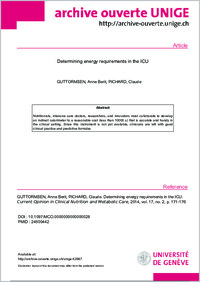Determining energy requirements in the ICU.
- Guttormsen AB aIntensive Care Unit, Haukeland University Hospital and University of Bergen, Bergen, Norway bClinical Nutrition, Geneva University Hospital, Switzerland.
- Pichard C
- 2014-02-07
Published in:
- Current opinion in clinical nutrition and metabolic care. - 2014
Calorimetry, Indirect
Critical Care
Critical Illness
Energy Intake
Energy Metabolism
Humans
Intensive Care Units, Pediatric
Nutritional Requirements
Nutritional Status
English
PURPOSE OF REVIEW
Resting energy expenditure in critically ill patients is highly variable depending on the diagnoses, illness severity, nutritional status, and treatments. The main questions are the following: What is the optimal energy target in my critically ill patient in the ICU at a given time point of the ICU stay? Is measured energy expenditure equivalent with energy requirement?
RECENT FINDINGS
There is uncertainty on the best way to feed the ICU patient; when to start, and what to give, especially concerning the amount of energy. Recent studies indicate that outcome is dependent on provision, components, and route. Indirect calorimetry is considered the gold standard to measure energy requirement and cannot be replaced by assumptions based on weight, height, sex, age, or minute ventilation. A main concern is that an indirect calorimeter with appropriate specifications to a reasonable cost is not available in the market. There are initiatives to solve this matter.
SUMMARY
Nutritionists, intensive care doctors, researchers, and innovators must collaborate to develop an indirect calorimeter to a reasonable cost (less than 10,000 €) that is accurate and handy in the clinical setting. Since this instrument is not yet available, clinicians are left with good clinical practice and predictive formulas.
Resting energy expenditure in critically ill patients is highly variable depending on the diagnoses, illness severity, nutritional status, and treatments. The main questions are the following: What is the optimal energy target in my critically ill patient in the ICU at a given time point of the ICU stay? Is measured energy expenditure equivalent with energy requirement?
RECENT FINDINGS
There is uncertainty on the best way to feed the ICU patient; when to start, and what to give, especially concerning the amount of energy. Recent studies indicate that outcome is dependent on provision, components, and route. Indirect calorimetry is considered the gold standard to measure energy requirement and cannot be replaced by assumptions based on weight, height, sex, age, or minute ventilation. A main concern is that an indirect calorimeter with appropriate specifications to a reasonable cost is not available in the market. There are initiatives to solve this matter.
SUMMARY
Nutritionists, intensive care doctors, researchers, and innovators must collaborate to develop an indirect calorimeter to a reasonable cost (less than 10,000 €) that is accurate and handy in the clinical setting. Since this instrument is not yet available, clinicians are left with good clinical practice and predictive formulas.
- Language
-
- English
- Open access status
- green
- Identifiers
-
- DOI 10.1097/MCO.0000000000000028
- PMID 24500442
- Persistent URL
- https://folia.unifr.ch/global/documents/62309
Statistics
Document views: 14
File downloads:
- fulltext.pdf: 0
